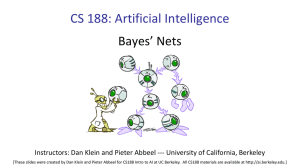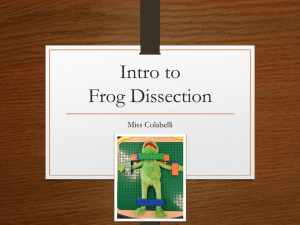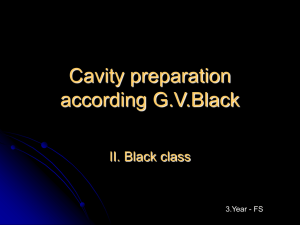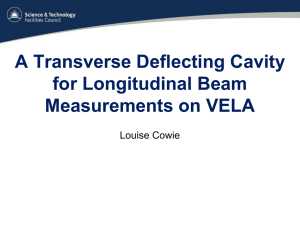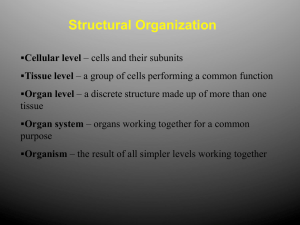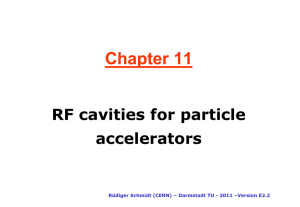Document
advertisement
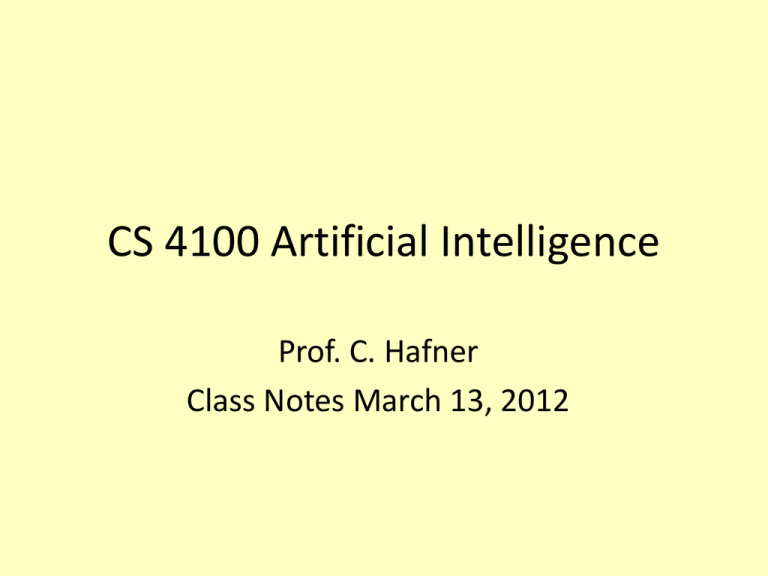
CS 4100 Artificial Intelligence Prof. C. Hafner Class Notes March 13, 2012 Outline • • • • • Probabilistic Reasoning Conditional Probability Independence Bayes’ Rule “Expert” systems and the combinatorics of joint probabilities • Bayes Rule and Conditional Independence • Thanks to Prof. Andrew Moore (CMU) for some slides on probabilistic AI. Probabilistic Reasoning • Basic element: random variable • Similar to propositional logic: possible worlds defined by assignment of values to random variables. • Boolean random variables e.g., Cavity (do I have a cavity?) • Discrete random variables e.g., Weather is one of <sunny,rainy,cloudy,snow> • Domain values must be exhaustive and mutually exclusive • Elementary proposition constructed by assignment of a value to a single random variable: e.g., Weather = sunny, Cavity = false (sometime abbreviated as cavity) • Complex propositions formed from elementary propositions and standard logical connectives e.g., Weather = sunny Cavity = false Syntax • Atomic event: A complete specification of the state of the world about which the agent is uncertain • E.g., if the world consists of only two Boolean variables Cavity and Toothache, then there are 4 distinct atomic events: Cavity = false Toothache = false Cavity = false Toothache = true Cavity = true Toothache = false Cavity = true Toothache = true • Atomic events are mutually exclusive and exhaustive (often called “Outcomes”) • Events in general are sets of atomic events, such as “Cavity = true” • Textbook uses P to denote the set of atomic events: P (Cavity, Toothache) called the probability distribution Axioms of probability • For any propositions A, B – 0 ≤ P(A) ≤ 1 – P(true) = 1 and P(false) = 0 – P(A B) = P(A) + P(B) - P(A B) Prior probability • Prior or unconditional probabilities of propositions e.g., P(Cavity = true) = 0.1 and P(Weather = sunny) = 0.72 correspond to belief prior to arrival of any (new) evidence • Probability distribution gives values for all possible assignments: P(Weather) = <0.72,0.1,0.08,0.1> (sums to 1) • Joint probability distribution for a set of random variables gives the probability of every atomic event on those random variables: P(Weather,Cavity) = a 4 × 2 matrix of values: Weather = Cavity = true Cavity = false sunny rainy 0.144 0.02 0.576 0.08 cloudy snow 0.016 0.02 0.064 0.08 • Every probability question about a domain can be answered by the joint distribution Conditional probability • Conditional or posterior probabilities e.g., P(cavity | toothache) = 0.8 i.e., given that toothache is all I know • (Notation for conditional distributions (use boldface): P(Cavity | Toothache) = 2-element vector of 2-element vectors) • If we know more, e.g., cavity is also given, then we have P(cavity | toothache,cavity) = 1 • New evidence may be irrelevant, allowing simplification, e.g., cavity does not depend on weather: P(cavity | toothache, sunny) = P(cavity | toothache) = 0.8 • This kind of inference, sanctioned by domain knowledge, is crucial for AI reasoning. How does it relate to what we learned earlier in this class ?? Conditional probability • Definition of conditional probability: P(a | b) = P(a b) / P(b) if P(b) > 0 • Product rule gives an alternative formulation: P(a b) = P(a | b) P(b) = P(b | a) P(a) • A general version holds for whole distributions, e.g., P(Weather,Cavity) = P(Weather | Cavity) P(Cavity) • (View as a set of 8 equations ( 4 Weather× 2 Cavity) Conditional probability • Chain rule is derived by successive application of product rule: P(X1, …,Xn) = P(X1,...,Xn-1) P(Xn | X1,...,Xn-1) = P(X1,...,Xn-2) P(Xn-1 | X1,...,Xn-2) P(Xn | X1,...,Xn-1) =… = P(X1) P(X2 | X1) P(X3 | X1, X2) . . . P(Xn | X1, . . ., Xn-1) OR: πi= 1 to n P(Xi | X1, … ,Xi-1) Inference by enumeration • Start with the joint probability distribution: • For any proposition φ, sum the atomic events where it is true: P(φ) = Σω:ω╞φ P(ω) Inference by enumeration • Start with the joint probability distribution: • For any proposition φ, sum the atomic events where it is true: P(φ) = Σω:ω╞φ P(ω) • P(toothache) = 0.108 + 0.012 + 0.016 + 0.064 = 0.2 Inference by enumeration • Start with the joint probability distribution: • Can also compute conditional probabilities: P(cavity | toothache) = P(cavity toothache) P(toothache) = 0.016+0.064 0.108 + 0.012 + 0.016 + 0.064 = 0.4 In class exercise • Given the joint distribution shown below and the definition P(a | b) = P(a b) / P(b): – What is P(Cavity = True) ? – What is P(Weather = Sunny) ? – What is P(Cavity = True | Weather = Sunny) • Given the meta-equation: – P(Weather,Cavity) = P(Weather | Cavity) P(Cavity) What are the 8 equations represented here? Weather = Cavity = true Cavity = false sunny rainy 0.144 0.02 0.576 0.08 cloudy snow 0.016 0.02 0.064 0.08 Independence • A and B are independent iff P(A|B) = P(A) or P(B|A) = P(B) P(B) or P(A, B) = P(A) P(Toothache, Catch, Cavity, Weather) = P(Toothache, Catch, Cavity) P(Weather) • 32 entries reduced to 12; for n independent biased coins, O(2n) →O(n) • Absolute independence powerful but rare • Dentistry is a large field with hundreds of variables, none of which are independent. What to do? Bayes' Rule • Product rule P(ab) = P(a | b) P(b) = P(b | a) P(a) Bayes' rule: P(a | b) = P(b | a) P(a) / P(b) • or in distribution form P(Y|X) = P(X|Y) P(Y) / P(X) = αP(X|Y) P(Y) • Useful for assessing diagnostic probability from causal probability: • – P(Cause|Effect) = P(Effect|Cause) P(Cause) / P(Effect) – E.g., let M be meningitis, S be stiff neck: P(m|s) = P(s|m) P(m) / P(s) = 0.8 × 0.0001 / 0.1 = 0.0008 – Note: posterior probability of meningitis still very small! Example: Expert Systems for Medical Diagnosis • 100 diseases (assume only one at a time!) • 20 symptoms • # of parameters needed to calculate P(Di) when a patient provides his/her symptoms • Strategy to reduce the size: assume independence of all symptoms • Recalculate number of parameters needed Bayes' Rule and conditional independence P(Cavity | toothache catch) = αP(toothache catch | Cavity) P(Cavity) = αP(toothache | Cavity) P(catch | Cavity) P(Cavity) • This is an example of a naïve Bayes model: P(Cause,Effect1, … ,Effectn) = P(Cause) πiP(Effecti|Cause) • Total number of parameters is linear in n Conditional independence • P(Toothache, Cavity, Catch) has 23 – 1 = 7 independent entries • If I have a cavity, the probability that the probe catches in it doesn't depend on whether I have a toothache: (1) P(catch | toothache, cavity) = P(catch | cavity) • The same independence holds if I haven't got a cavity: (2) P(catch | toothache,cavity) = P(catch | cavity) • Catch is conditionally independent of Toothache given Cavity: P(Catch | Toothache,Cavity) = P(Catch | Cavity) • Equivalent statements: P(Toothache | Catch, Cavity) = P(Toothache | Cavity) P(Toothache, Catch | Cavity) = P(Toothache | Cavity) P(Catch | Cavity) Conditional independence contd. • Write out full joint distribution using chain rule: P(Toothache, Catch, Cavity) = P(Toothache | Catch, Cavity) P(Catch, Cavity) = P(Toothache | Catch, Cavity) P(Catch | Cavity) P(Cavity) = P(Toothache | Cavity) P(Catch | Cavity) P(Cavity) I.e., 2 + 2 + 1 = 5 independent numbers • In most cases, the use of conditional independence reduces the size of the representation of the joint distribution from exponential in n to linear in n. • Conditional independence is our most basic and robust form of knowledge about uncertain environments. Bayesian networks • A simple, graphical notation for conditional independence assertions and hence for compact specification of full joint distributions • Syntax: – a set of nodes, one per variable – a directed, acyclic graph (link ≈ "directly influences") – a conditional distribution for each node given its parents: P (Xi | Parents (Xi)) • In the simplest case, conditional distribution represented as a conditional probability table (CPT) giving the distribution over Xi for each combination of parent values


